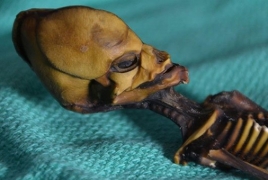
The mystery of a tiny skeletal mummy that has captured the public’s imagination and baffled scientists for years may have finally been solved, The Huffington Post reports.
The body is just 6 inches long and likely a fetus; however, it has a skeletal structure that appears to be that of a 6-year-old child. Since the mummy had 10 pairs of ribs instead of 12 and an elongated head, some believed it could be an alien.
But DNA tests confirmed that the skeleton, nicknamed “Ata” as it was discovered in Chile’s Atacama Desert in 2003, was human.
“I had heard about this specimen through a friend of mine, and I managed to get a picture of it,” Garry Nolan, a professor of microbiology and immunology at Stanford University, said in a news release. “You can’t look at this specimen and not think it’s interesting; it’s quite dramatic.”
The analysis by Nolan and a team of other researchers confirmed that the skeleton was not an alien, nor a primate as some had speculated. It was the fetus of a girl who had suffered from a host of severe genetic mutations. Some of those mutations had never been linked to bone or developmental problems.
Nolan told the Guardian that Ata was either a stillborn or died right after birth.
“She was so badly malformed as to be unable to feed,” he said. “In her condition, she would have ended up in the neonatal ICU, but given where the specimen was found, such things were simply not available.”
The tests also showed that the remains weren’t ancient, as some had theorized, but only about 40 years old.
Nolan said: “While this started as a story about aliens, and went international, it’s really a story of a human tragedy. A woman had a malformed baby, it was preserved in a manner and then ‘hocked’ or sold as a strange artefact. It turns out to be human, with a fascinating genetic story from which we might learn something important to help others. May she rest in peace.
“DNA differences like this are useful to help us diagnose children and adults with ‘undiagnosed’ disorders,” Atul Butte, director of the Institute for Computational Health Sciences at the University of California-San Francisco, told CBS news.
“More and more children’s hospitals are able to study patients and better understand what differences in their DNA might be leading to their conditions or disorders,” Butte added. “And the ones we learned here can get added to the catalogs for future reference.”

